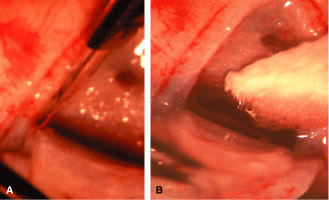

|
| Fig. 35. A and B. Deep sclerectomy with viscocanalostomy: creation of trabeculodescemetic membrane. Identifying and cannulating Schlemm's canal is difficult, but creating this thin gossamer membrane is even more difficult. The deep scleral flap is normally tethered anteriorly by the anterior boundary of Schlemm's canal. This anterior boundary must be extended approximately 1.5 mm anteriorly into clear cornea. This is accomplished by making a radial extension on the sides of the canal into clear cornea with a diamond knife (A). The tendency is to go to shallow for fear of penetrating into the anterior chamber. The correct depth down to Descemet's is necessary to allow the flap to extend anteriorly. A Weck-cell sponge (B) is useful to facilitate blunt dissection of the deep flap from Descemet's, however, excessive force will assuredly cause rupture into the anterior chamber. The sponge is useful to gauge flow through the thin membrane. Most investigators recommend removing the thin inner wall of Schlemm's canal from the floor of the canal to encourage flow. |